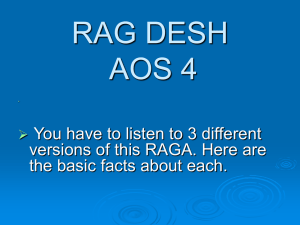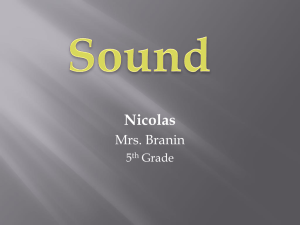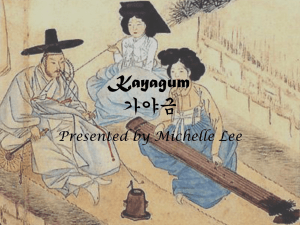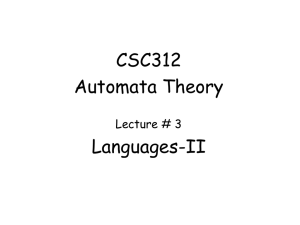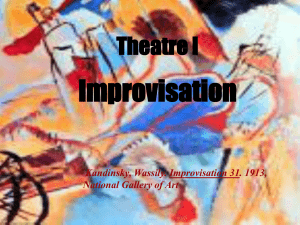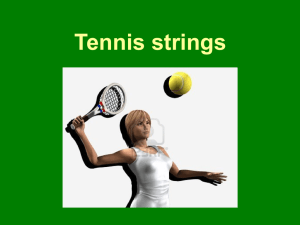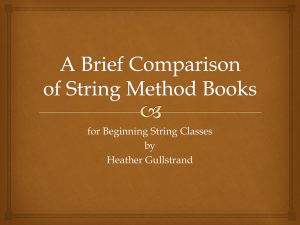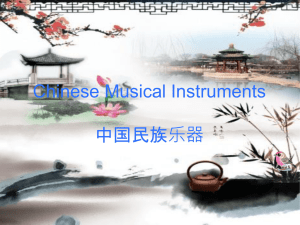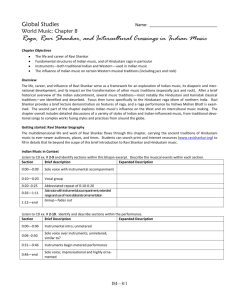Week 6 - Bath Spa University
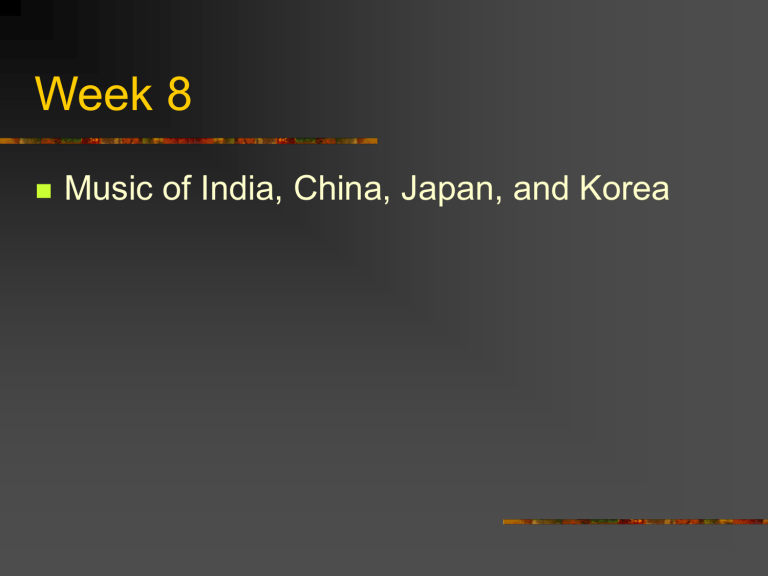
Week 8
Music of India, China, Japan, and Korea
Indian Music
1.
2.
3.
4.
Vedic Period (2 nd Millenium BC- 2 cent AD – chanting
Classical Period (C2-13) – divided the ragas into male/female and alloted them fixed times and moods (rasas).
Medieval (C13-16) – distinction between North and South appears
Modern (C16 onwards) recognisable as applying to modern practice.
General Characteristics
The emphasis on plucked strings is like W. Asia, though the virtuoso drumming is unique.
Great Tradition to qualify for which the music must be:
1. Governed by a authentic doctrine.
2. Learned through an authentic aural tradition.
The formal term for classical music is `sastriyasangrit’ (scientific music), but it is commonly known as `ragdar’, I.e. based on raga.
North and South India
Hindustani (Northern provinces, inc. Pakistan,
Bangladesh)
Carnatic (Southern peninsula)
Both use drones and have three melodic roles.
1. Main melody (either sung, or played on a plucked string or reed instrument).
Optional accompanying melody (either played on a bowed string instrument if with a voice, or a reed instrument)
Independent percussion.
Both North and South use raga and tala
Fixed Forms in Indian Music
Drupad (vocal) - Alap, Nom-tom Alap,
DRUPAD, INPROVISATION
Gat (instrumental) – Alap, Jor, Jhala, GAT
(slow), IMPROVISATION, GAT (Fast),
IMPROVISATION.
Khayal – KHYAL CHIZ (slow), ALAP,
IMPROVISATION, KHYAL CHIZ (fast),
IMPROVISATION
Indian Terms
Alap is the improvisatory prelude with drone that explores the notes of the raga.
Jor (= Nom-tom alap in vocal music) explores higher tetrachords, and becomes more rhythmic as it progresses.
Jhala – pulsating tonic, constant stroking of drone strings, climax in anticipation of entry of drummer.
Classical Indian Instruments
Vina – Ancient long-necked lute, with 4 strings tuned in
4 th /5ths, 24 fixed frets, wooded bowl.
Bin (N) – Stick Zither, like vina, with 2 gourds.
Sitar (N) – Long-necked lute, with 3-7 strings, moveable frets and 12-13 sympathetic strings.
Sarod – 6 gut strings, plucked or bowed, no frets, 12 SS
Tambura – Long-necked lute, 4 strings used for drone only.
Saragi – fiddle with no frets, 3 strings and SS
Dilruba – fiddle with frets, 3/4/strikngs and SS
Chinese Periods
Formative – C3 B.C. to C4 AD. Earliest artificates – ocarinas, theoretical writings . 1,
M=Origin myths, 2. Theoretical writings, 3.
Instruments pf court, 4. Relationship of music to court life in Chou and Han dynasties (3 rd
Century B.C. to 220 AD).
Pipes basis for elaborate tone system – pitch uniformity crucial for good government.
Chinese LU system – cyclic set of pitches from tubes whose lengths were mathematically proportioned – giving basic Chinese scale. 5tone scale with two changing tones.
General Points
Chinese music part of natural philosophy.
System of ordering musical instruments by
8 sounds – earth, stone, metal, skin, wood, bamboo, gourds, silk.
Instruments used then – Ch’in, P’ipa,
Sheng, still in use today.
International Period – 5
th
to 10
th
century
Sui and Tang dynasties – new instruments
– sets of hanging bells and iron slabs.
Chordophones (played by professional female musicians) – P’ipa, moon guitar, hu ch’in (2 string fiddle from Mongolia) and
San hsien.
Centre of music shifted from Confusian rites to public stage and homes of wealthy.
National Period – 10
th
– 19
th
Centuries
Sung dynasty (960 – 1279) new stability – development of language, poetry and drama.
Mongols invaded 1279 – development of exclusive repertoires for particular instruments.
Good forms of instrumental notation.
Chang dynasty (1644-1911) saw development of
Peking Opera – addition of zither – (dulcimer developed from West)
Since Cultural Revolution there has been both a loss of tradition and an attempt to revive and rediscover ancient traditions.
